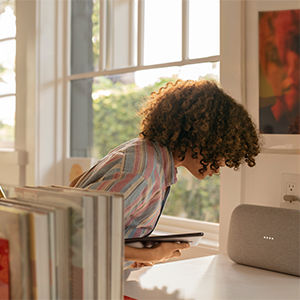A guide to voice-activated technology
Voice recognition technology is a software program or hardware device that has the ability to decode the human voice. Sometimes referred to as voice-activated or speech recognition software, this technology has become more and more popular in recent years among everyday consumers. Many people incorporate these devices into multiple facets of their homes to perform commands, find information, or make recordings more conveniently. In fact, the size of the voice commerce market is expected to increase significantly over the next several years, growing from $2 billion in 2018 to $40 billion by 2022.
With voice-activated technology becoming more pervasive and accessible, it’s important for you to understand more about it before inviting it into your life, home, or workplace. As with any piece of new technology, you should know how it works and the various ways in which you can use it, as well as some of its disadvantages and the various concerns and risks that may come from using it. After all, voice-activated technology is an exciting new development that is changing the way people interact with and use technology, and it’s likely only going to become increasingly integrated into consumers’ daily lives.
How does voice recognition work?
Although using voice recognition technology is as simple as uttering a few words, the way it works is actually quite complex. First, speech recognition software filters through the sounds you speak and translates them into a format it can “read.” Then, it analyzes that “translation” for meaning and uses that information — along with its algorithm and previous inputs — to guess what you said.

If you are the only person using a piece of voice-activated technology, its ability to understand you and your meaning will improve over time, becoming more and more accurate. Things get far more complex when accounting for other users, different languages and dialects, and the other factors that can affect human speech. Even common changes, such as background noise or vocal inflections, can affect how voice-activated technology understands a speaker.
Many types of voice-activated technology actually “learn” language in the same way that human children do: language input. The Linguistic Society of America claims that “children acquire language quickly, easily, and without effort or formal teaching. It happens automatically [...] Children who are never spoken to will not acquire language.” In other words, children learn based on how other people use language with and around them. Similarly, voice recognition systems must receive language input and be interacted with in order to learn how to recognize patterns and make connections in human language. Without this input and training, many voice recognition systems likely would not be able to function as well or as accurately as they currently do.
Despite these difficulties, various voice recognition systems continue to improve and advance in their ability to understand human speakers. For example, at the end of 2016, Microsoft’s speech recognition technology reached a level of understanding similar to that of humans themselves, and Google’s own voice recognition software attained a level of 95% recognition accuracy not long after. As researchers continue to teach, train, and develop voice recognition technology, it could become even more accurate in the future.
Types of recognition systems
There are a variety of different kinds of systems that fall under the larger umbrella of voice-activated technology. Other common types of recognition systems include:
- Speaker dependent systems: Requires training before use and is thus dependent on a speaker to be functional. Users may have to read a series of words, phrases, and sentences to help train the system.
- Speaker independent systems: Does not require training before use and is already capable of understanding most user’s voices. Many popular voice assistants use speaker-independent systems.
- Discrete speech recognition: Requires users to speak words one-at-a-time or with pauses between each word, as the system can only understand words and their meanings individually.
- Continuous speech recognition: Allows users to speak at a normal rate when interacting with the system.
- Natural language: Can understand a user’s words and their meaning, and can also respond to them, provide answers to questions, complete commands, or deliver requested information.
How is voice activation and recognition used?
Though it has only seen widespread use in the last several years, voice activation and recognition technology already have myriad applications in different facets of everyday life. As a matter of fact, it’s become so popular so quickly that you’ve probably used or encountered voice-activated technology already. Some popular uses for voice-activated technology include:
- Cars: Many cars now have voice-activated technology integrated directly into the vehicle itself. This includes things like smart car speakers and connected car hotspots to allow for easier and safe hands-free driving.
- Home appliances: Many appliances, devices, and systems are now connected to the internet and to each other to make it easier than ever before for people to control, protect, and enjoy their homes. Many of these different smart home devices, such as thermostats and security systems, also make use of voice activation for that same purpose.
- Laptops & tablets: It’s now common for laptops and tablets to have voice recognition built into the device so you can embrace a hands-free experience when you need or want to.
- Personal digital assistants: Personal digital assistants are among the most popular uses of voice-activated technology. Many — such as Google’s Hey Google and Apple’s Siri — are integrated directly into popular smartphones so you can use them regardless of where you are or what you’re doing.
- Wearable technology: Similarly, wearable technology like fitness trackers and smartwatches also allows you to use voice recognition whenever you have your device on your person. This can make it easier to use these devices altogether since they tend to have small screens and buttons.

Advantages and disadvantages of voice activation.
Regardless of how you use it, there are both advantages and disadvantages that come from using voice activation technology. Some of the biggest advantages include:
- Accessibility: Voice activation allows a greater number of people to access digital technology, connected devices, and the internet more easily. It improves accessibility for people with disabilities, especially for individuals who have impaired vision or motor functions.
- Connection: Voice activation can easily work with other connected technologies and devices in your home, such as smart appliances and speakers. This connection makes it that much simpler and faster to accomplish different tasks in your home.
- Convenience: Using voice activation can be significantly more convenient than typing something out on a keyboard or smartphone or manually completing a task. Of the Americans who use digital assistants, 55% claim that being able to use their devices hands-free is a major reason they use voice activation at all. When using voice-activated technology, you’re able to use your mind and hands to do something else.
- Personalization: Voice-activated technology creates a more personalized digital experience for users. This can include remembering information from previous interactions, offering helpful reminders, and distinguishing between multiple users from voice alone. In other words, the more you use voice activation, the easier and better it is for you to use.
On the other hand, there are also disadvantages and barriers to using voice-activated technology that can affect consumers’ ability to engage with it. Some of the biggest concerns about it include:
- Cost: Different devices that make use of voice activation, including speakers and smart appliances, can be costly for some people. They may only be able to afford one piece of voice-activated technology, such as a smartphone, and miss out on the benefits of connecting and using multiple devices.
- Inaccuracy: Although the accuracy of voice-activated technology has increased dramatically in the last several years, it still isn’t perfect. You’ll likely still encounter some minor inaccuracies or errors when using voice activation.
- Limitations: Voice-activated technology is currently capable of only doing so much. There are limitations to how it can be used, and it will take more time to discover more applications and uses of voice recognition.
- Multi-tasking: You may think that using voice recognition helps you multitask, but it may actually just be disruptive. For example, a growing body of research indicates that using voice assistant technology can still be a distraction for drivers, especially when it doesn’t work accurately.
Depending on how you engage with voice-activated technology and what you use it for, though, the benefits may easily outweigh the drawbacks (or vice versa). It all depends on what type of experience you want to have with voice recognition.
Is voice control technology secure?
Just as with virtually any piece of new technology such as mobile pay and even cell phones in and of themselves, there are concerns about the security of voice recognition technology. It’s true that you do take some risks when using any type of voice-activated technology. Common threats include hackers being able to access your private information, duplicating or copying your voice to make commands or purchases, or leveraging the voice recognition software to control other connected devices in your home. These are very real privacy and security threats that can compromise sensitive information, your finances, and your home.
However, threat researcher Candid Wueest notes that “these devices do not present more risk than a smartphone or laptop.” All of the main concerns that stem from voice-activated technology are also a risk when using other connected devices. And as with other types of technology, there will always be hackers and fraudsters looking to take advantage of any potential vulnerabilities for their own benefit. Further, as voice-activated technology becomes more sophisticated and integrated into day-to-day life, it will likely become more secure and safe for consumers to use.


